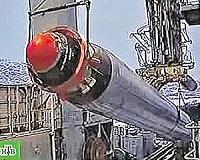 |
Moscow (UPI) Apr 27, 2011 Russia has successfully test-fired a Sineva ballistic missile from one of its nuclear-powered submarines, a spokesman of the Russian Defense Ministry said. Fired from the Delta-IV class Yekaterinburg submarine that was diving in the Barents Sea, the third-generation, liquid-propellant RSM-54 Sineva missile (NATO codename Skiff) hit its target on time, the spokesman told Russian news agency RIA Novosti. The missile, produced by the Krasnoyarsk Machine-Building Plant, can be fired from under water at targets more than 6,000 miles away. It's able to carry up to 10 warheads and is a key segment of Russia's nuclear deterrent. The Russian navy's last missile test was in October 2010, when a pair of submarines fired a Sineva and a Stingray ballistic missile, with both hitting their respective designated targets, Russian officials said at the time. The latest test comes as Washington and Moscow are negotiating to reduce their nuclear weapons arsenal. Washington is making every effort to reach an agreement, U.S. Assistant Secretary of State Rose Gottemoeller said last week. "Consistent with the president's agenda to reduce the role and number of nuclear weapons and the Senate's call for pursuing negotiations with Russia on tactical nuclear weapons, we are working intensively throughout our government on these issues while also consulting with our NATO allies," Gottemoeller was quoted as saying during her speech at the U.S. Naval Academy in Annapolis, Md. "We will be working with NATO to shape an approach to reduce the role and number of forward-based U.S. non-strategic nuclear weapons in Europe, as Russia takes reciprocal steps to reduce its non-strategic nuclear weapons and relocate them away from NATO's borders," she added. Russian Prime Minister Vladimir Putin said in March that Russia would double its ballistic missile production starting in 2013 and spend, over the next decade, around $2.6 billion on new strategic and tactical missiles such as Yars, Bulava and Iskander-M. In what was seen as a major step forward for anti-proliferation efforts, the presidents of the United States and Russia, Barack Obama and Dmitry Medvedev, last spring signed a new arms reduction treaty. Ratified by U.S. and Russian lawmakers in December and January, it cuts the number of strategic warheads in each country to 1,550, down from 2,200; and the number of land-, air- and sea-based launchers to 800, down from 1,600.
Share This Article With Planet Earth
Related Links Learn about nuclear weapons doctrine and defense at SpaceWar.com Learn about missile defense at SpaceWar.com All about missiles at SpaceWar.com Learn about the Superpowers of the 21st Century at SpaceWar.com
 Russia test launches Sineva strategic missile
Russia test launches Sineva strategic missileMoscow (AFP) April 26, 2011 The Russian military successfully test launched a Sineva ballistic missile Tuesday from a submarine in the Arctic, the Interfax news agency quoted a defence ministry spokesman as saying. "The launch was carried out from underwater in the Barents Sea from the Yekaterinburg nuclear submarine. At the expected hour, the payload of the Sineva missile arrived at the Kura range in Kamchatka" in Rus ... read more |
|
| The content herein, unless otherwise known to be public domain, are Copyright 1995-2010 - SpaceDaily. AFP and UPI Wire Stories are copyright Agence France-Presse and United Press International. ESA Portal Reports are copyright European Space Agency. All NASA sourced material is public domain. Additional copyrights may apply in whole or part to other bona fide parties. Advertising does not imply endorsement,agreement or approval of any opinions, statements or information provided by SpaceDaily on any Web page published or hosted by SpaceDaily. Privacy Statement |